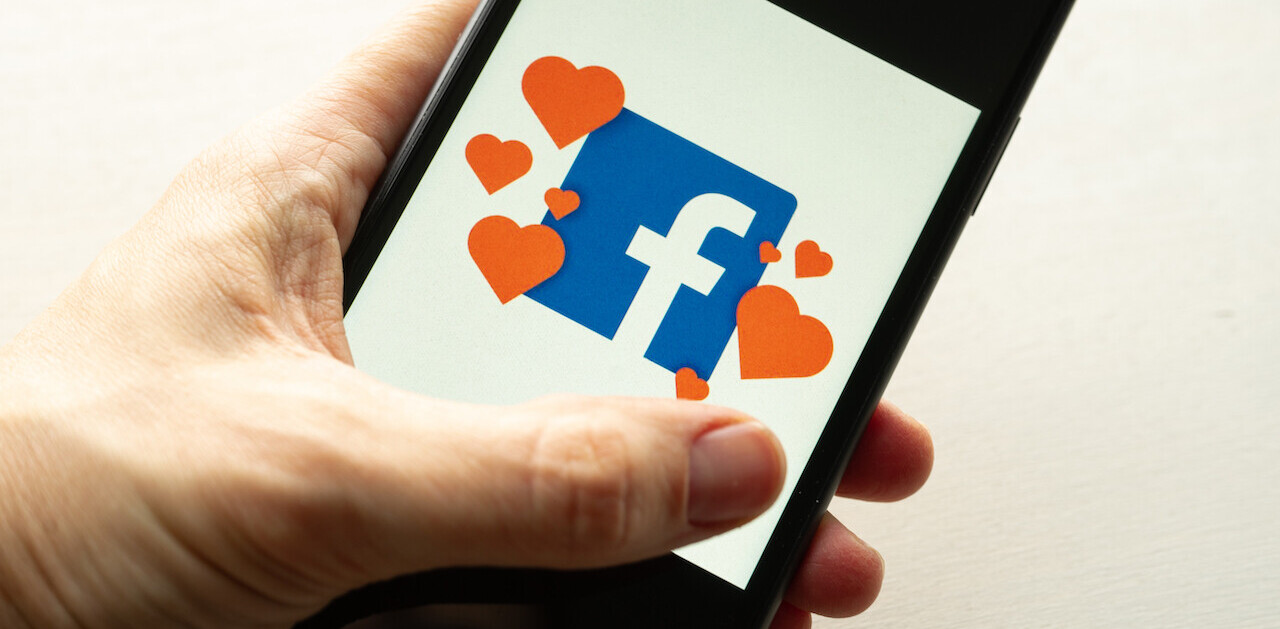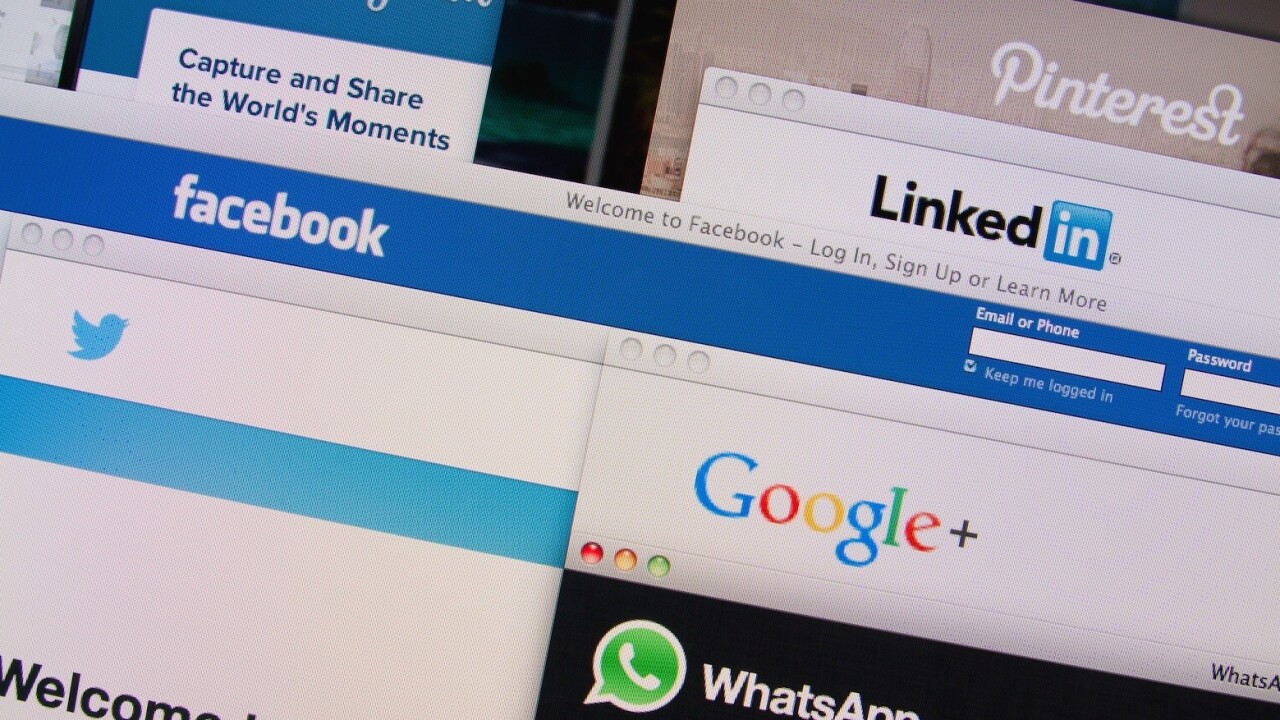
Driving business from social media isn’t as easy as blasting out your own self-promotional content and waiting for the customers and revenue to trickle in. Despite what some marketers may think of social media, it’s more complicated than that.
Social media is a funnel just like the rest of your marketing channels, and in order to turn your fans and followers into paying customers you need to move them through each stage of the conversion process. One effective way to do that is to follow this five step social media funnel geared at turning people who have never heard of your brand into loyal customers.
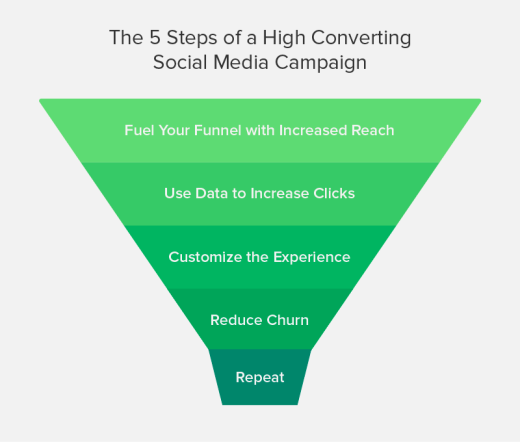
This post doesn’t just show each of the steps, it also includes actionable social media strategies that will help you augment the size of your audience at each phase, which will inevitably lead to more social success.
1. Fuel Your Funnel With Increased Social Reach
The first step to almost any funnel is to increase awareness, as those who have never heard of your brand are less inclined to purchase your goods or services. Well “reach” is essentially awareness for social networks–it’s the amount of people who have seen one of your social posts.
It’s easy to say that you need to increase your social reach, but how exactly can you get your posts in enough social media streams to make an actual difference for your brand? Here are a few ways to increase reach and fuel the top of your social funnel.
Optimize for Social Shares
One of the quickest ways to exponentially increase your social reach is to get it shared, since your post will then be immediately shared another person or brand’s social media audience. I’ve found one of the most effective ways to get shares is to actually mention the popular companies and thought leaders in your space and build on that relationship so that when they’re looking for content to share you stay top of mind.
For example, out of all of my Tweets, the ones that saw the most reach were those that mentioned other companies or thought leaders.

It was incredibly exciting to see that I had gotten over 56,000 reach on a post as I usually see about 300.
Get to Know the Social Network Algorithms
Some of the top social networks have introduced algorithms that choose which posts will be shown in a specific user’s social media feeds. Networks like Facebook have incorporated these algorithms as a way to reduce the noise on social media, ensuring only some of the top content appears in the News Feed. To make sure that you’re getting the most possible reach out of your posts it’s important to know some of the acceptable–and unacceptable–posting practices.

The above example is the Facebook Edgerank algorithm. It’s made up of a ton of different factors and is constantly tweaked, but if you can follow all of the News Feed updates you’ll have a better idea of what the network appreciates, and will be rewarded with additional reach.
Experiment with Real-Time Marketing
As the popular networks continue to decrease free social media reach marketers need to find new, creative ways to reach their audience without having to pay for ads. One such way is with “real-time marketing”. Real-time marketing is the idea of using popular world events or trends in your social media posts in order to boos relevance and increase overall reach.
Though it’s possible you’ve never heard of real-time marketing, there’s a very good chance you’ve seen it in action.

The example above was sent from Arby’s during the 2014 Grammy’s when singer Pharrell came out on stage with a hat that looked oddly similar to the Arby’s signature logo. Arby’s saw amazing engagement with it’s use of real-time marketing and gained over 77,000 ReTweets, leading to a massive increase in reach.
Embrace the Use of Hashtags
Though hashtags have become somewhat stigmatized in recent years, they still serve a very valuable purpose: making social posts around relevant topics easily searchable. So if you can find any sort of mildly popular hashtag that is relevant to your brand, try using it in your social posts for a boost in reach.
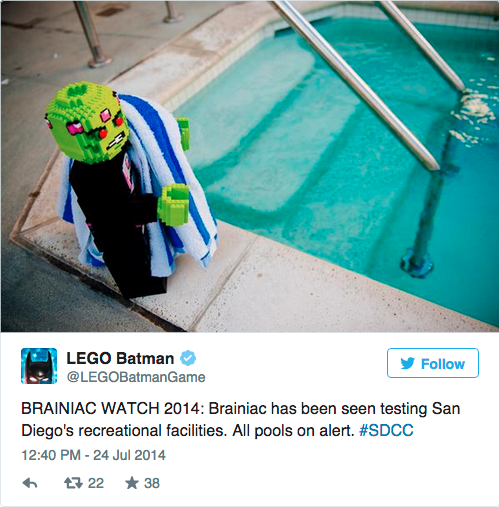
The above example shows low LEGO took advantage of the San Diego Comic-Con hashtag to promote one of their own products. The key thing to remember when using hashtags is that they need to be relevant to your brand; people will notice if you’re only using popular hashtags to spam your own products.
2. Create Content That Drives Clicks to Your Site
Boosting the reach of your post is amazing. It will lead to fantastic brand awareness that will help expose your brand and drive direct and search traffic back to your site. Although that’s great, the better opportunity lies in getting those seeing your posts to click through to your content and actually visit your website then and there. To do that you’ll need to create content that actually drives clicks. Here are some ways that you can do that.
Figure Out Which Copy Resonates
A great way to drive more clicks to your site is to figure out what exactly it is your social fans and followers click on. One way you can do this is by downloading a report of all of your past social media posts with a tool like Sprout Social and figure out what has driven the most post clicks in the past. Some of the things to consider when looking through past post performance are:
- Did you share a photo, link or video?
- Did you ask your audience to click?
- What kind of voice did you write with?
- Are there any buzzwords that drive more clicks?
Then start to use that information to dictate your copy-writing and posting strategy moving forward.
Figure Out Which Day of the Week to Post
Our temperaments, interests and needs change as we move throughout the days of the week, and so should our social media strategy. There’s a good chance that your customers are more likely to click your posts on some days of the week more than others.
While looking through the historical reports that you pulled in the above step you can also manipulate the data to see exactly which days of the week your content is most likely to get clicked.
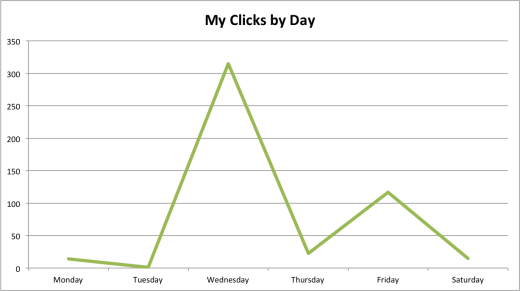
For example, I’ve created the above chart based on my own Twitter data. My data is rather limited—which could explain the large fluctuations—but most brands will have enough information to get a very solid idea of the best days of the week to post.
Figure Out Which Time of the Day to Post
Our moods change as we go through the day just as when we go through the week, and it’s possible to figure out which time of the day you should post to draw in more clicks. This will definitely require you to have more data than figuring out which day of the week to post, and it’s best to consolidate the time into blocks of hours.
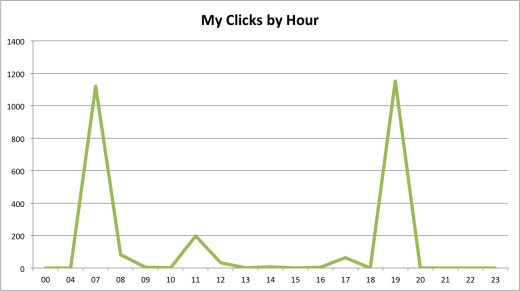
This should give you an idea of when during the day customers are most inclined to click on your social media posts, and you can use that to inform when you schedule your social messages.
3. Use a Unique Landing Page to Convert Visitors
So far you’ve figured out how to increase your social media reach to fuel the top of your funnel, and how to get those people seeing your messages to actually click through to your site. Now what do you need to do? You need to create and use landing pages that will actually get these visitors to convert to leads or customers.
Oli Gardner, professional landing page creator and co-founder of the company landing page software Unbounce, often says “NSAMCWADLP,” which is an abbreviation for “Never Start A Marketing Campaign Without A Designated Landing Page.” This means you should create a unique landing page for each of your big marketing campaigns, as your social media messaging should match the landing page to make for a better user experience. KISSmetrics is an example of a company that does a fantastic job matching social posts to landing pages.

The above social media posts brings you to a landing page clearly built specifically for that campaign.

By telling customers exactly what they should expect when they click through your ads it’s likely that you’ll see an increase in conversions on your page, fully completing step three of our social media marketing funnel.
4. Engage With Customers to Reduce Churn Rate
Just because a customer has converted on your page doesn’t mean your social campaign is over. There’s always the chance that the person who bought your product or service—or those who have signed up for a software you provide—will have issues with it or decide that it isn’t the best fit for them.
The best thing that you can do in this situation is engage with them to assuage their remorse and quell any post-purchase dissonance, and social media is a great place to do just that. Unfortunately, most brands don’t seem to realize the importance of social media for customer service, and business engagement rates are abysmal.
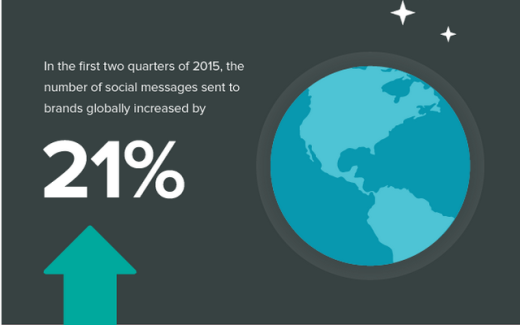
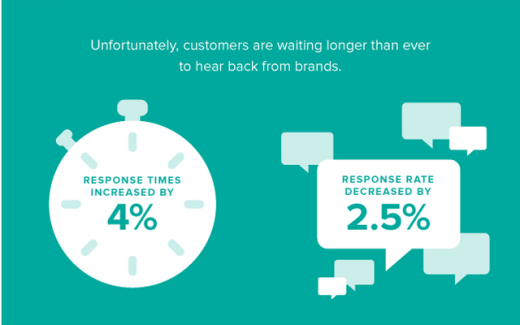
Embrace these strategies to make sure that you don’t fall into this category, and make sure you’re providing amazing customer service.
Respond to All Inbound Messages in a Timely Manner
Based on the above data, it’s pretty clear that people are going to reach out to your company on social media sites. That’s why you should make sure to respond to all of those customers—not including any trolls—in a timely manner.
One company doing an extremely good job at engaging with its customers is Royal Dutch Airlines. The airline actually changes the header image of its Twitter profile every five minutes to tell customers how long they should expect to wait before hearing a response.
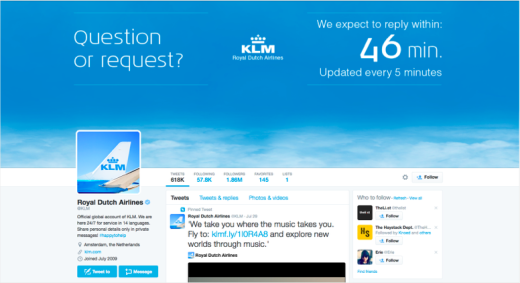
The airline also managed to reach 100 percent engagement rate, an astounding feat for such a large company.

Providing this level of customer service will help ensure that customers keep coming back to your brand.
Monitor for Non-Branded Social Media Mentions
Not every person mentioning your brand on social media sites will tag you. In fact, many people probably assume that you’ll never even see the messages that they post. Taylor Evans in the example below is one such person who probably thought the brand she mentioned wouldn’t see her post.
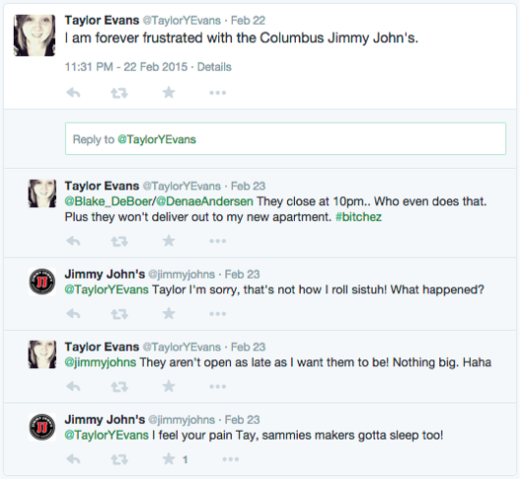
By monitoring social media for its brand name, Jimmy John’s was able to turn this negative customer message into a positive experience. The customer went from calling Jimmy John’s #bitchez to actually favoriting the social post.
Get Your Whole Team on Social Media
These last two strategies show just how much effort social media management can be, and if you’re serious about boosting your response rates you may want to get more people from your team online to help.
For instance, a software company may want to get some of their engineers on social so that way if someone sends a support message to their brand, the engineers can provide service. It doesn’t have to stop there either. There are a number of different departments that could benefit from a social media presence.
- Sales
- Finance
- Marketing
- Customer Service
- Research & Development
Social media works best as a collaborative effort, so start recruiting your co-workers to join the team.
5. Build on Customer Relationships to Increase Lifetime Value
Up to this portion of the funnel, you should have generated tons of new impressions, clicks, site visitors and satisfied customers from your social media efforts. Not bad for a channel that some companies still don’t see much use in. The key to the final step of this funnel is to continue to build relationships with your customers to get them—as well as those in their networks—back to your website for additional purchases.
Though it’s heavily dependent on on your industry, it can cost between 4 and 10 times as much to acquire a new customer than to retain a current customer. For that reason you should always continue interacting with past and current customers in order to drive them back to your site for additional sales opportunities.
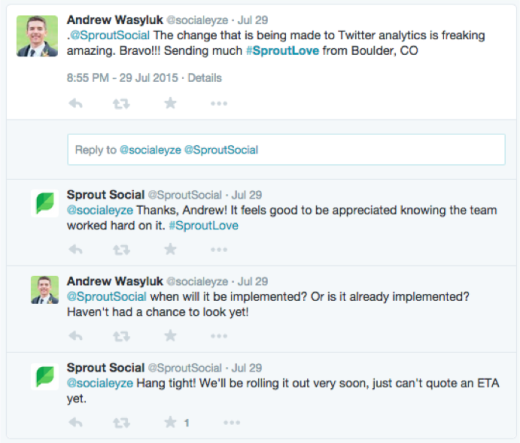
The example above shows how the team at Sprout Social engages with customers on social. By continuing the conversation with this fan we’re building on the relationship, and by extension encouraging him to continue to use our product.
Encourage Brand Advocacy from Customers
Not only does Sprout keep that relationships growing in the above example, but we also benefit from an increase in brand exposure and reach generated from our loyal customers. As the customer in the example above began his Tweet with a period, it was shown to all of his Twitter following as well, bringing us full circle and re-fueling the top of our funnel.
Customers can be some of your strongest brand advocates, and word-of-mouth marketing is an important channel for brands. Continuing to engage with customers and fans will often result in an increase in advocacy.
Increase Reach Through User-Generated Content
Finally, another fantastic way to boost your overall reach is to solicit user-generated content from your social fans and followers. User-generated content are any photos, videos and social updates that your fans create for your brand that you can go on to share over social.
UGC isn’t just great because it provides brands with shareable content, but it can also help get your brand in front of your followers’ followers. One great example of a company utilizing UGC for increased reach is GoPro.

GoPro encourages users to share their photos on Instagram and to tag the company in order to win the “Photo of the Day” contest. The best part of this contest for GoPro is that each time a contest participant takes a photo and tags their GoPro, the participant’s followers will be exposed to the brand as well.
So get out there and test out this funnel for your own social media marketing strategy. If you need some help, check how Sprout Social can help you create and refine your social media funnel.
Read Next: 7 metrics to grow your community
Image credit: Shutterstock
This post first appeared on Social Media Today.
Get the TNW newsletter
Get the most important tech news in your inbox each week.





